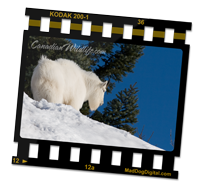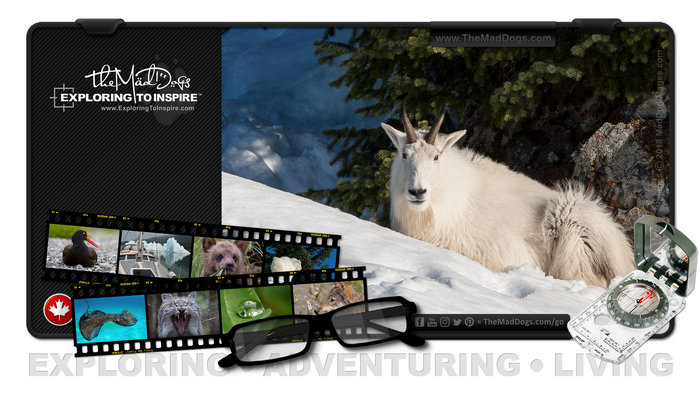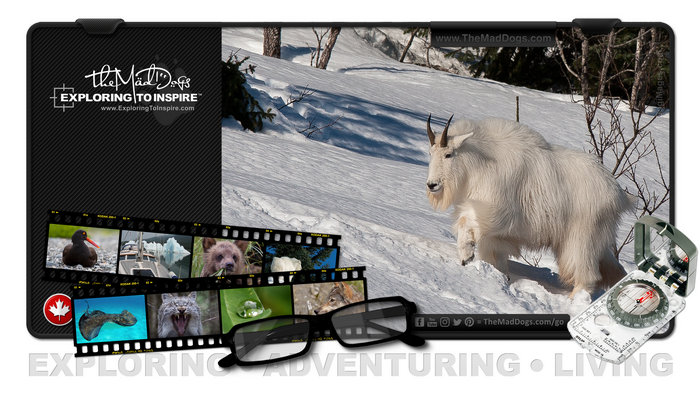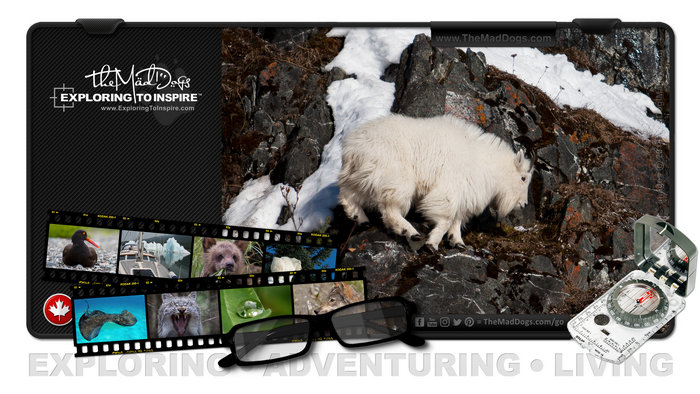Welcome to Canadian Wildlife
--
The
wild side of Canada™ |
Copyright notice: All text, layout,
images and graphical representations are copyright ©
2010
Mad Dog
Digital and may not be copied, reproduced or
transmitted without the written consent of
Mad Dog
Digital. Please contact us for more
information |
|
|
|
|
Details about:
Mountain Goats in Canada & Alaska (USA) |
| |
 Mountain
Goats Mountain
Goats
Mountain goat in
the winter
High in the alpine forest, Mountain Goats
majestically sport glimmering white fur coats.
The Mountain Goat, standing in its bright white coat
in sheer contrast to the black cliff face is a true
expert of mountaineering. Sharp rimed hooves,
surrounding a softer, almost rubbery, inner sole
allows these climbing pros to bound upon and hug
even the tinniest cliff edges.
Mountain Goats are an even-toed ungulate. While they
are in the same family as true goats, they belong to
a different genus (meaning they are genetically
diverse). Male mountain goats, called billies, stand
on average 36” - 42” (90 cm - 105 cm) at the
shoulder, measure 48” - 68” (120 cm - 170 cm) long
(from nose to tail) and weigh between 100 lb - 300
lb (45 kg - 136 kg). Female mountain goats, called
nannies, are usually 10% - 30% lighter and smaller
than the billies.
Adult billies and nannies appear very similar
visually. Both billies and nannies grow horns, up to
9” (22 cm) long for nannies and up to 12” (30 cm)
long for billies, as well, both grow beards, with
the billies beards being longer, up to 5” (12 cm) in
total length, than the nannies. These beards
however, are not true beards, but are an extension
of the neck hair. |
| |
 |
| |
The horns, hooves, nose and eyes are black
contrasting their glamorous, bright yellowish-white
fur. The coat of the Mountain Goat is made up of two
layers of hair. The outer hairs, being hollow,
provide excellent weather resistance as well as
capturing and glimmering in the sunlight. The inner
coat is a dense soft hair that provides the
excellent insulation needed to survive in their
alpine home. The combination of inner- and
outer-coat keeps Mountain Goats warm in temperatures
as low as -50° F (-45° C) and in winds up to 100 mph
(160 km/h). In the spring, the billies are the first
to shed the warm undercoat with the pregnant nannies
shedding later.
In May & June nannies give birth to a single kid,
weighing only 6½ lbs (3 kg). Within hours the kid
can walk and tries to run and jump about. The nanny
protects the kid from the hazards of youth, standing
over top of them when danger approaches and even
positioning themselves downhill from the kid in case
of an accidental slip or fall. |
| |
 |
| |
Usually active in the mornings and evenings, they
can sometimes be observed grazing during full moon.
The Mountain Goat’s individual daily movements tend
to be constrained to a certain area, rock face,
cliff ledge or alpine meadow. It is as a group,
depending on food availability that they move to a
new area. Primarily seen in their alpine homes
grazing on grass, shrubs and sedges, they can be
seen to descend down to the waters edge during the
winter months.
Mountain Goats perform grand displays of aggression
when defending their territories and grazing areas
from other mountain goats and even bighorn sheep,
however, unlike the bighorn sheep, they have fragile
horns and skulls and very rarely will get into a
head-butting fight. Nannies are very adept at
protecting themselves and their kids from predators
using both their horns and sharp rimmed hooves. |
| |
 |
| |
| Mountain Goat herds form loose groups, separating
the nannies & kids from the billies, relying on
their keen eyesight and the remoteness of their high
alpine location for safety as they mill about,
climbing up and down rock faces, defying gravity as
they search for their favorite greens. |
| |
 |
| |
|
Return to our main animals in
Canada page |
| |
 |
| |
| |
|
|
|



